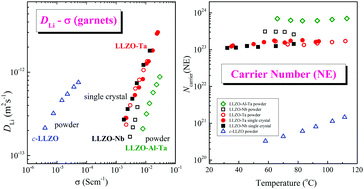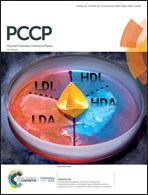Relationship between Li+ diffusion and ion conduction for single-crystal and powder garnet-type electrolytes studied by 7Li PGSE NMR spectroscopy†
Abstract
Ion-conducting garnets are important candidates for use in all-solid Li batteries and numerous materials have been synthesized with high ionic conductivities. For understanding ion conduction mechanisms, knowledge on Li+ diffusion behaviour is essential. The proposed nano-scale lithium pathways are composed of tortuous and narrow Li+ channels. The pulsed gradient spin-echo (PGSE) NMR method provides time-dependent 7Li diffusion on the micrometre space. For powder samples, collision-diffraction echo-attenuation plots were observed in a short observation time, which had not been fully explained. The diffraction patterns were reduced or disappeared for single-crystal garnet samples of Li6.5La3Zr1.5Ta0.5O12 (LLZO-Ta) and Li6.5La3Zr1.5Nb0.5O12 (LLZO-Nb). The inner morphology and grain boundaries affect importantly the collision-diffraction behaviours which is inherent to powder samples. The 7Li diffusion observed by PGSE-NMR depends on the observation time (Δ) and the pulsed field gradient (PFG) strength (g) in both powder and single-crystal samples, and the anomalous effects were reduced in the single-crystal samples. The scattered Li diffusion constants converged to a unique value (DLi) with a long Δ and a large g, which is eventually the smallest value. The DLi activation energy was close to that of the ionic conductivity (σ). The DLi values are plotted versus the σ values measured for four powder and two single-crystal garnet samples. Assuming the Nernst–Einstein (NE) relation which was derived for isolated ions in solution, the carrier numbers (NNE) were estimated from the experimental values of DLi and σ. The NNE values of metal-containing garnets were large (<1023 cm−3) and insensitive to temperature. They were larger than Li atomic numbers in cm3 calculated from the density, molecular formula and Avogadro number for LLZOs except for cubic LLZO (Li7La3Zr2O12, NNE ∼ 1020 cm−3).



 Please wait while we load your content...
Please wait while we load your content...